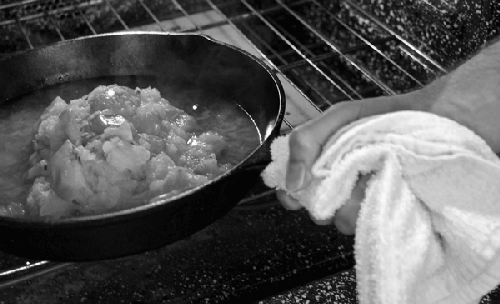1.6. Thermometers and timers
Probe thermometers are awesome because they use a thermocouple attached to a long
heat-safe lead, designed so that you can stick the probe into a piece of meat and set
the controller to beep when it reaches the desired temperature. Timers are handy, and if
you’ll be doing much baking, one will be critical. But if you expect to be doing mostly
cooking, a timer is just a proxy for checking when, say, an oven roast has reached
temperature, in which case why not use something that actually checks that? And when it
comes to food safety, it’s not possible to “see” what a hamburger cooked to 160°F / 71°C
looks like, even when cut in half.
Infrared thermometers are great for
taking dry temperatures, such as the surface temperature of a frying pan before you
start making pancakes, or ice cream you’ve just made with liquid nitrogen . The other great
thing about them is that they’re instant: point, click, done. You can also use them to
take the temperature of liquids in a pan without having to worry about handling a hot
thermometer probe or washing it after. Keep in mind, though, that stainless steel is
reflective in the IR range, just like a mirror reflects visible light—you’ll end up
taking the temperature of your ceiling, not the pan, if you try to meter an empty
stainless steel pan. Also, IR thermometers only take surface temperature, so they
shouldn’t be used for checking internal temperatures for food safety.
Tuck a probe thermometer into a quiche or pie to tell when the
internal temperature indicates it is done. I pull my quiches out when the
temperature reaches 140°F / 60°C. The egg coagulates in the range of 140–149°F /
60–65°C, and 140°F / 60°C is hot enough that the “carryover” heat will just set
the egg custard without making it dry.

Finally, I’d be remiss if I didn’t mention the most overlooked but useful
thermometer: your hands. Learn what various temperatures feel like: hold your hand above
a hot pan, and notice how far away you can be and still “feel” the heat (thermal
radiation). Stick your hand in an oven set to medium heat, remember that feeling, then
compare it when you’re working with a hot oven. For liquids, you can generally put your
hand in water at around 130°F / 55°C for a second or two, but at 140°F / 60°C it’ll
pretty much be a reflexive “ouch!” Just remember to use a thermometer for foods that
need to be cooked to a certain temperature for food safety reasons.
1.7. Mixing bowls
While you can get away with using your dinner plates or soup bowls for holding some
things, you’ll invariably need mixing bowls for working with and storing your
ingredients. I recommend two types: large metal bowls (~12 to 16″ / 30 to 40 cm
diameter) and small glass bowls.
For metal bowls, poke around your nearest restaurant supply store for some cheap
stainless steel ones, which should cost only a few dollars apiece. These bowls are large
enough to hold cookie dough, cake batter, and soup, and they have enough room for
chopped leafy greens that you plan to sauté. You can also toss them in the oven at low
heat to keep cooked items warm, something you can’t do with plastic ones.
Small glass bowls are also very useful, especially if you’re using a mise
en place setup. Measuring out chopped ingredients into small glass bowls
ahead of time will allow you to toss the ingredients together much faster during the
cooking process. If you have leftovers, just wrap the bowls with plastic wrap and store
in the fridge. Look for glass bowls that are all the same size and that stack well.
You’ll often find these bowls available at your local hardware store.
1.8. Bar towels
In addition to wiping off counters with
them, you can use bar towels (typically 12″ × 18″ / 30 × 40 cm terry towels with some
thickness) as potholders, under a cutting board to prevent slippage, or as a liner in a
bowl to help dry washed items such as blueberries or cherries. And you can never have
enough of them. I keep several dozen on hand in my kitchen.
You can use a bar towel as a potholder to handle dishes or pans that
have been in the oven. Fold it in half to double the thickness, and don’t use a
wet towel because it’ll steam up and burn you. Some people prefer oven mitts,
because oven mitts are typically thicker and don’t have the potential to catch on
corners like a towel might.
